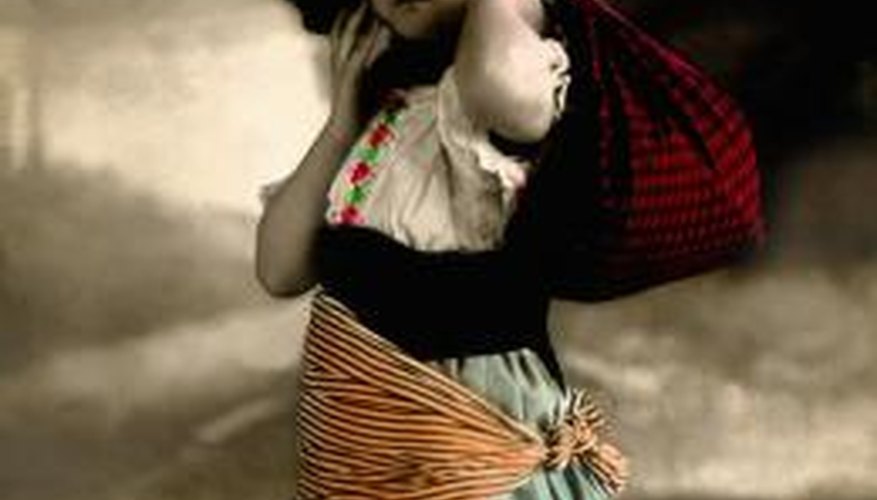The traditional crafts of Gypsy people -- who are now more frequently referred to as Romani or Romany people -- reflect their troubled history. Originally from northern India, the Romani began emigrating westward around 1000 B.C. They spread through Europe where their language, customs and tightly-knit clans were viewed with suspicion. Always on the outskirts of society, and often the victims of discrimination and persecution. they developed a nomadic lifestyle to avoid conflicts with residents and authorities. Romani are dispersed throughout the world, and their culture has evolved in different ways. However, traditional Romani crafts are rooted in their nomadic lifestyle.
Baskets
Romani people have a long tradition of basket weaving that developed partly because the raw material was free and could be found almost anywhere along their travel routes. Weavers used white weeping willow tree branches stripped of bark to make baskets for household uses.They also boiled the branches until they were a reddish-brown colour and wove them into tighter, stronger baskets with leather handles made to carry heavy loads. The demand for Romani baskets, which have always been more functional than decorative, gradually faded with plastic and machine-made products. These baskets are still made but their production is limited.
- Romani people have a long tradition of basket weaving that developed partly because the raw material was free and could be found almost anywhere along their travel routes.
Wood Carving
Romani woodworkers are known for the elaborate coach-style wagons built to travel in caravans. They also carve many small items such as platters, bowls, clothes pins, pegs to hang coats, and churia -- work knives with short, stout handles and steel blades. Although the designs for these functional items are simple and solid, some Romani woodworkers also carve decorative items such as wall plaques and wooden flowers made by partly shaving the wood of a tree branch to form petals. Romani artisans also carve elaborate lattice and fretwork pieces similar to the designs used on wagons.
- Romani woodworkers are known for the elaborate coach-style wagons built to travel in caravans.
- Although the designs for these functional items are simple and solid, some Romani woodworkers also carve decorative items such as wall plaques and wooden flowers made by partly shaving the wood of a tree branch to form petals.
Metal Working
Historically Romani people have depended heavily on horses and all communities had skilled blacksmiths in their ranks. Their experience with metals helped them build a reputation as skilled tinkers and coppersmiths. When they passed through cities and towns, local people sought them out to repair pots, buckets and tools. Some Romani craftsmen still make heavy, handcrafted cauldrons and cooking utensils, but most metal working is now geared toward decorative items such as candle holders, weather vanes, iron gates and small pieces of wrought iron accent furniture. In some areas, Romani have developed silver and gold working skills that are applied toward making simple jewellery.
- Historically Romani people have depended heavily on horses and all communities had skilled blacksmiths in their ranks.
- In some areas, Romani have developed silver and gold working skills that are applied toward making simple jewellery.
Leather
Leather working is also a traditional Romani skill that has evolved over time. Harnesses, crops and saddles were the focus of early Romani leather work, and some artisans still make products for the equestrian market. Other Romani artisans who work with leather today make handcrafted coin pouches, sheathes for knives, bags, belts, leather clothing, and simple shoes.
